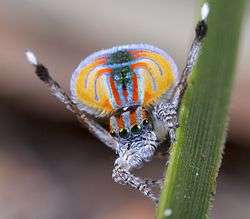Maratus volans
Maratus volans is a species in the jumping spider family (Salticidae), belonging to the genus Maratus (peacock spiders).
| Maratus volans | |
|---|---|
 | |
| Male | |
| Courtship rituals | |
| Scientific classification | |
| Kingdom: | Animalia |
| Phylum: | Arthropoda |
| Subphylum: | Chelicerata |
| Class: | Arachnida |
| Order: | Araneae |
| Infraorder: | Araneomorphae |
| Family: | Salticidae |
| Genus: | Maratus |
| Species: | M. volans |
| Binomial name | |
| Maratus volans (O. P-Cambridge, 1874)[1] | |
| Synonyms[1] | |
| |
Description
Both sexes reach about 5 mm in body length. Females and immatures of both sexes are brown but have color patterns by which they can be distinguished from related species. Also, the males dance to attract females.
Behavior
The red, blue and black colored males have flap-like extensions of the abdomen with white hairs that can be folded down. They are used for display during mating: the male raises his abdomen, then expands and raises the flaps so that the abdomen forms a white-fringed, circular field of color. The species, and indeed the whole genus Maratus have been compared to peacocks in this respect. The third pair of legs is also raised for display, showing a brush of black hairs and white tips. These legs are also used in a clapping motion to further attract a female's attention. While approaching the female, the male vibrates his abdomen while waving raised legs and tail, and dances from side to side.[2][3]
If the male continues his dance when the female is not interested, she attempts to attack, kill, and feed on him; she may also do this after mating (sexual cannibalism).[4] The male may escape by jumping. The behavior of the female M. volans suggests why the males have developed unique sexual dimorphic features and courtship behavior.[5]
M. volans use their colorful opisthosomal flaps to gain the attention of the female. Much of the mating ritual consists however of waving and vibrating the third legs, for between four and fifty-minutes.[6] Jakob Bro-Jergensen states that "When both sexes are allowed to respond optimally by introducing adaptive dynamics to a standard runaway model of condition dependent signaling, multiple signals can coexist even if the signal preferences entail significant costs".[7] He explains that the potential sexual success outweighs the relatively low costs of the mating ritual. The mating behaviour of M. volans is an example of runaway sexual selection where the male risks death in attempting to mate.[8][5][9]
Peacock spiders are diurnal cursorial hunters feeding primarily on insects and other spiders. The evolution of an acute visual system in salticids almost certainly originated as an adaptation for stalking prey. However, this development also facilitated a wandering lifestyle different from that of their sit-and-wait ancestors, enabling jumping spiders to roam and encounter many environments. Keen eyesight has probably been useful for peacock spiders in navigating, inhabiting and exploiting new types of habitats, and undoubtedly set the stage for the evolution of complex visual signals.[10]
Distribution
M. volans is confined to specific parts of Australia (Queensland, New South Wales, Australian Capital Territory, Western Australia and Tasmania).[11]
Name
The English arachnologist Octavius Pickard-Cambridge described the species. It was transferred to the genus Maratus by Marek Żabka in 1991,[12] noting that "it is difficult to describe adequately the great beauty of the colouring of this spider".[13]
The specific name volans means "flying" in Latin; O.P-Cambridge noted that the person who sent him the specimens from New South Wales had told him that he had seen the spiders "actually using [the flaps] as wings or supporters to sustain the length of their leaps."[13] This belief has been debunked by the Australasian Arachnological Society.[14][15]
References
- "Taxon details Maratus volans (O. Pickard-Cambridge, 1874)". World Spider Catalog. Natural History Museum Bern. Retrieved 2016-06-17.
- https://www.youtube.com/watch?v=9GgAbyYDFeg
- "Archived copy". Archived from the original on 2014-10-06. Retrieved 2014-10-01.CS1 maint: archived copy as title (link)
- Evans, 1990
- Thornhill, 1984
- Girard, 2011
- Bro-Jorgensen, 2009
- Prum, 2010
- Bergstrom, 2012
- Girard, Madeline B.; Endler, John A. (2014-07-07). "Peacock spiders". Current Biology. 24 (13): R588–R590. doi:10.1016/j.cub.2014.05.026. ISSN 0960-9822. PMID 25004358.
- Platnick 2009
- Waldock, Julianne M. (20 November 2008). "What's in a name? Or: why Maratus volans" (Salticidae) cannot fly" (PDF). www.australasian-arachnology.org. Retrieved 30 September 2013.
- Pickford-Cambridge, Octavius (1874). "On some new genera and species of araneidea". Annals and Magazine of Natural History. Fourth series. London: Taylor & Francis. 14 (81): 160–182. doi:10.1080/00222937408680951. Retrieved 29 September 2013.
- http://www.australasian-arachnology.org/myths/maratus_cannot_fly
- http://www.australasian-arachnology.org/download/Maratus_cannot_fly.pdf
Sources
- Ed Nieuwenhuys: Peacock spider
- David Edwin Hill 2009: "Euophryine jumping spiders that extend their third legs during courtship (Araneaee: Salticidia: Euophryinae: Maratus, Saitis)". Peckhamia 74(1): 1-27.
- Jurgen C Otto and David E Hill 2011: "An illustrated review of the known peacock spiders of the genus Maratus from Australia, with description of a new species (Araneae: Salticidae: Euophryinae)." Peckhamia 96.1: 1-27.
- Thornhill, R., Alcock, J., (1984).The Evolution of Insect Mating Systems, Science Ne Series, 223(4638), 808-809
External links
| Wikimedia Commons has media related to Maratus volans. |